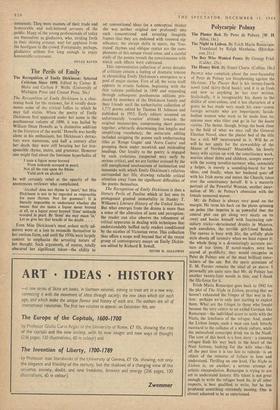The Perils of Emily
The Recognition of Emily Dickinson: Selected Criticism Since 1890. Edited by Caesar R. Blake and Canton F. Wells. (University of Michigan Press and Cresset Press, 50s.) The Recognition of Emily Dickinson is a chas- tening book for the reviewer, for it vividly docu- ments some of the critical follies to which he may fall victim. When the poetry of Emily Dickinson first appeared under her name in the posthumous volume of 1890, it was hailed by William Dean Howells as 'a distinctive addition to the literature of the world.' Howells was hardly alone in his enthusiasm, but Dickinson's detrac- tors were numerous, and half a century after her death they were still berating her for irre- sponsible rhyme, metre, and grammar. However one might feel about the feminine hyperbolics of I taste a liquor never brewed ' From tankards scooped in pearl;
Not all the vats upon the Rhine Yield such an alcohol!
he will certainly rebel at the opacity of the anonymous reviewer who complained, 'Alcohol' does not rhyme to 'pearl,' but Miss Dickinson is not to be regarded as responsible for mere rhymes. Nor for grammar! It is literally impossible to understand whether she means that she tastes a liquor never brewed at all, or a liquor never brewed 'from' tankards scooped in pearl. By 'from' she may mean 'in.' Let us give her that benefit of the doubt. . . .
Even Miss Dickinson's most ardent early ad- mirers were at a loss to reconcile themselves to her curious form, and until the 1930s were largely content to emphasise the arresting nature of her thought. Such arguments, of course, totally obscured her significant talent—the ability to
set conventional ideas (as a conceptual thinker she was neither original nor profound) into such concentrated and arresting imagistic frames that they are endowed with renewed sig- nificance; the abrupt shifts in metre, the 'frus- trated' rhymes and oblique syntax are the com- plements of this unique visual sense, and a careful study of the poems reveals the consciousness with which such effects were cultivated.
This representative collection of seven decades of criticism creates a feeling of dramatic tension in chronicling Emily Dickinson's emergence as a poet of major stature. First of all, the verse itself appears in erratic fashion, beginning with the thin volume published in 1890 and expanding through subsequent posthumous editions pro- duced by members of the Dickinson family and their friends until the authoritative collection of 1,775 poems edited by Thomas H. Johnson and published in 1955. Early editors assumed an unfortunately 'creative' attitude towards the original manuscripts, compressing short poems together, arbitrarily determining line lengths and simplifying vocabulary; the autocratic editing included assigning the poems such embarrassing titles as 'Rouge Gagne' and 'Astra Castra' and grouping them under mawkish and misleading headings. Our loyalty to the poetry is engaged by such violations (suspected very early by serious critics), and we are further aroused by the still unexplained smokescreen of insinuation and innuendo with which Emily Dickinson's relatives surrounded her life, drawing valuable critical attention away from the significant difficulties of the poems themselves.
The Recognition of Emily Dickinson is thus a literary Perils of Pauline which at last sees its protagonist granted immortality in Stanley T. Williams's Literary History of the United States. But what emerges from the drama is more than a sense of the alteration of taste and perception; the reader can also observe the refinement of critical apparatus in dealing with techniques that
understandably baffled early readers conditioned ( by the niceties of Victorian verse. This collection thus offers a scope well beyond that of the recent group of contemporary essays on Emily Dickin- son edited by Richard B. Sewall.
DAVID D. GALLOWAY




























 Previous page
Previous page